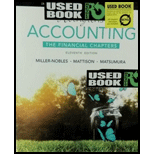
Concept explainers
Payback period, accounting
All the above are the methods of capital budgeting which are having separate principles of deciding on which investment shall be taken up:
Payback period: This method is based on principle that the projects which recover which initial
Accounting rate of return: This method computes the simple rate of return on the average investment involved in the projects and the projects which provides the highest return shall be accepted.
Net Present value: This method is based on principle of time value of money and takes decision on the basis of net residual
Internal return of return: This method also suggests the rate of return which the investment will realize after considering the present value of cash inflows and outflows. The
Profitability Index: Profitability index is also a proportion of present value of cash inflows and initial investment. The project with higher ratio shall be accepted over the other projects.
Requirement1-a:
Thepayback period of the project shall be determined.
Requirement 1-b:
The Accounting rate of return of the project shall be computed.
Requirement1-c:
The net present value of project at 12% discount rate shall be computed.
Requirement1-d:
The Internal rate of return shall be determined
Requirement1-e:
The Profitability index of the project shall be determined.
Requirement2:
The decision on the project acceptance or rejection to be taken.
Want to see the full answer?
Check out a sample textbook solution
Chapter 26 Solutions
Horngren's Accounting, The Financial Chapters (11th Edition) - Standalone Book
- Please explain the solution to this general accounting problem with accurate explanations.arrow_forwardCan you help me solve this financial accounting problem with the correct methodology?arrow_forwardThe assets of Nike Industries consist entirely of current assets and net plant and equipment. The firm has total assets of $8,400,000 and net plant and equipment of $3,200,000. The company has long-term debt of $1,800,000, and common equity of $3,600,000. The firm has no preferred stock. What is the balance of current liabilities on the firm's balance sheet?arrow_forward
- I need assistance with this financial accounting problem using valid financial procedures.arrow_forwardThe inventory at the end of the year?arrow_forwardGranite Tools Inc. disposed of an asset at the end of the fifth year of its estimated life for $12,000 cash. The asset's life was originally estimated to be 7 years. The original cost was $49,000, with an estimated residual value of $7,000. The asset was being depreciated using the straight-line method. What was the gain or loss on the disposal?arrow_forward
- Nonearrow_forwardTesla Car Service started the year with total assets of $320,000 and total liabilities of $210,000. During the year, the business recorded $510,000 in revenues, $370,000 in expenses, and dividends of $45,000. What is the net income reported by Tesla Car Service for the year?arrow_forwardCan you help me solve this general accounting problem using the correct accounting process?arrow_forward
- I am trying to find the accurate solution to this financial accounting problem with appropriate explanations.arrow_forwardPlease provide the accurate answer to this general accounting problem using appropriate methods.arrow_forwardI am searching for the accurate solution to this general accounting problem with the right approach.arrow_forward

 AccountingAccountingISBN:9781337272094Author:WARREN, Carl S., Reeve, James M., Duchac, Jonathan E.Publisher:Cengage Learning,
AccountingAccountingISBN:9781337272094Author:WARREN, Carl S., Reeve, James M., Duchac, Jonathan E.Publisher:Cengage Learning, Accounting Information SystemsAccountingISBN:9781337619202Author:Hall, James A.Publisher:Cengage Learning,
Accounting Information SystemsAccountingISBN:9781337619202Author:Hall, James A.Publisher:Cengage Learning, Horngren's Cost Accounting: A Managerial Emphasis...AccountingISBN:9780134475585Author:Srikant M. Datar, Madhav V. RajanPublisher:PEARSON
Horngren's Cost Accounting: A Managerial Emphasis...AccountingISBN:9780134475585Author:Srikant M. Datar, Madhav V. RajanPublisher:PEARSON Intermediate AccountingAccountingISBN:9781259722660Author:J. David Spiceland, Mark W. Nelson, Wayne M ThomasPublisher:McGraw-Hill Education
Intermediate AccountingAccountingISBN:9781259722660Author:J. David Spiceland, Mark W. Nelson, Wayne M ThomasPublisher:McGraw-Hill Education Financial and Managerial AccountingAccountingISBN:9781259726705Author:John J Wild, Ken W. Shaw, Barbara Chiappetta Fundamental Accounting PrinciplesPublisher:McGraw-Hill Education
Financial and Managerial AccountingAccountingISBN:9781259726705Author:John J Wild, Ken W. Shaw, Barbara Chiappetta Fundamental Accounting PrinciplesPublisher:McGraw-Hill Education





